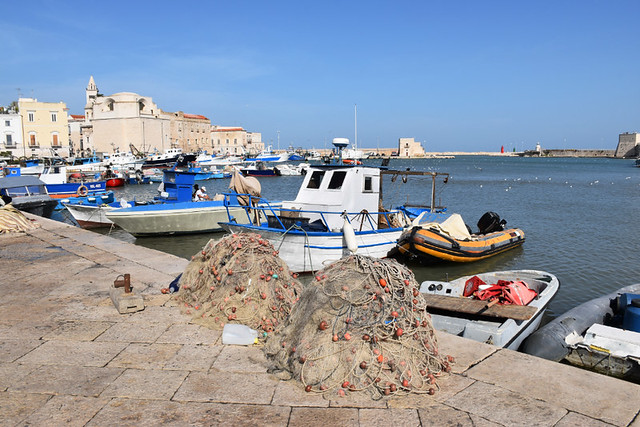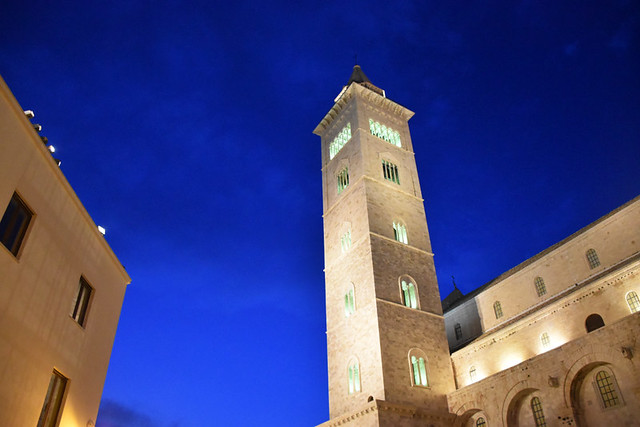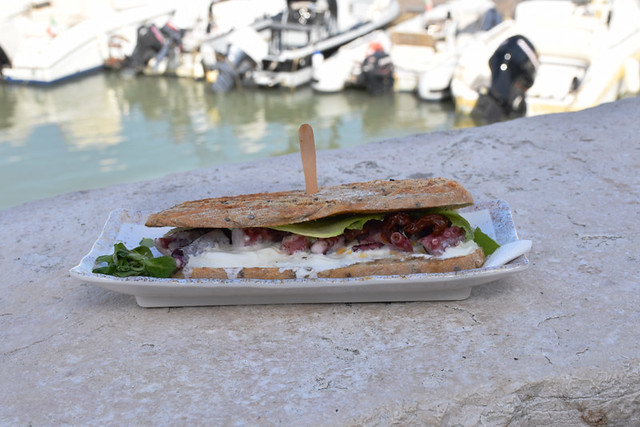Travelling from Locorotondo in the hills of Italy’s heel to Trani on the Adriatic shouldn’t have presented much of a problem, a taxi ride to Fasano, then simply jump on one of the trains that regularly run along the coast, connecting all the main towns and cities. Shouldn’t have … except on the day we were travelling there was a national train strike.
But here’s the thing, travelling by train in Italy isn’t the same as travelling by train in Britain. Even during a strike, a core service still operates. So, although we had to wait longer than usual at Fasano – long enough for me to leave a grease stain on my trousers courtesy of a particularly tasty slice of focaccia (worth it) – the strike only delayed our onward journey by an hour or so. By midday, we’d swapped a pretty, white hilltop town for a honey-coloured one on the sunny coast.
Trani is only one of a raft of attractive coastal towns in Puglia, most boasting similar, but not exactly the same, ingredients – usually a historic centre set around a harbour, with a beach or two thrown in. We were there to put together an Inntravel journey which takes in some of the highlights of Puglia and Trani was a convenient base for exploring what this stretch of the Italian coastline had to offer curious travellers.
A bit of background
A lack of beaches means Trani is generally bypassed by many foreign tourists, yet this elegant little town was once an important trading port, second in the Adriatic only to Venice. Knights Templars set off from Trani on their way to the Crusades, and it was in Trani that the oldest known maritime trading law in the west – the Ordinamenta Maris – was established in the 11th century. A flourishing trade attracted wealthy families from Amalfi, Genoa, and Venice. Its good fortune was partially linked to the presence of a sizeable Jewish community, the largest in southern Italy, which was awarded a monopoly on the manufacture and sale of raw silk. Trani’s prosperous status changed during the 15th and 16th centuries under Angevin and Aragonese rule, when many Jews were expelled, and the city suffered a period of crisis. The Bourbon regime in the 17th and18th centuries boosted both the economy and the standard of architecture; sumptuous marble palaces were constructed, adding a further touch of class to the town’s already distinguished good looks.
First impressions
The layout is much like any other coastal town along this stretch of the Adriatic, step off the train, follow a long, straight road toward the coast and, hey presto, before too long you’re in the historic centre. The only difference is what each approach to the centro storico looks like. Trani’s consisted of a pristine street lined with oleanders, shops, and café/bars before we arrived at the shady Piazza della Republica where we were almost seduced into pausing for a coffee at the cool and arty Ultimo Café. The piazza lies on the fringe of the historic centre, which can be a confusing warren of narrow alleys and lanes to negotiate. Trani’s immaculate, crescent-shaped harbour is coy, remaining virtually hidden until we were in danger of emerging from a backstreet to fall into the briny. That’s an exaggeration, but we did drag cases along a parallel street behind the harbour for 400m without catching a glimpse of its turquoise waters until we reached Chiesa Santa Teresa on the harbour. It quickly became apparent to us that Trani was an affluent town. Not in an ostentatious way though, there were no garish displays of wealth – the harbour filled with fishing boats and small craft rather than blingy yachts – but Trani looked and felt like a town on its uppers. Buildings constructed from local limestone lend the town a ‘just had a scrub in the bath’ look.
The big attraction
There isn’t one, not really. The picturesque harbour with its restaurants and bars is the main draw, and that’s more than enough when the objective is to chill out in exceedingly pleasant surroundings that provoke a feeling of wellbeing. On a warm, sunny day in late October it was a tranquil, relaxing environment. The only intrusion came from the bellowing cries of fishermen selling various denizens of the deep from stalls dotted around the harbour. But you’d have to be Scrooge on holiday to find that something to moan about. Standout sight is the 12th century Trani Duomo dominating the seafront at the west end of the harbour. There are detailed descriptions outside all of Trani’s historic buildings, but information like ‘Above the transept runs a cornice with corbels in a somewhat classical style…’ has me glazing over, so I scan these types of info boards quickly for interesting (or gruesome) snippets, before having a wander around and deciding how interesting buildings are with my eyes. The Duomo is a gorgeous structure. The local limestone has a pinkish hue, which gives the façade a quite beautiful sheen, especially when lit up at night. On the opposite side of the piazza, vying for attention, is the 12th century Castello Svevo di Trani, whose design was inspired by Crusader castles in the Holy Land.
The historic quarter
The oldest part of Trani lies in the streets directly behind the Duomo, this is where most of the ancient churches and palaces are located. It’s also home to the Jewish quarter, and alleys so narrow you can just about touch both sides at the same time. Arches span some of these, making sections feel more like tunnels. There are no shops or cafes, just a sense of time-travelling. Randomly exploring these ancient lanes reminded me of wandering around Essaouira in Morocco and Lamu Town in Kenya, as though I’d left Europe behind.
Other meanderings
Apart from promenading along the seafront, a wander through the Arco dei Militari and along the wide battlements of the protective arm of Fortino Sant’Antonio rewarded with a ‘wow, that’s good’ view of Trani harbour. To get there involved entering the Villa Communale, the town’s public gardens, which itself is worth a linger. Forget serene strolling though, the gardens are the noisy haunt of squabbling and squawking Monk parakeets. Far less rowdy is a colony of terrapins doing not a lot except clamber over each other to reach the sunniest position in one of the park’s ponds.
Food and drink breaks
Trani has an interesting culinary scene. There’s the obvious attraction of tucking into fresh fish and seafood overlooking the harbour, but side and back streets contain a delectable blend of restaurants, ranging from traditional to avant-garde. As well as two Michelin star restaurants there are other creative establishments, like Lab57 Bottega Gastronomic where the chef enjoys getting imaginative with pasta shapes. Even the fast food can be classy in Trani, a couple of café bars sell gourmet paninis along the seafront. We only managed to try one, Champagnerie, which does a pretty mean octopus panini.
As for nightlife, the usual focus would be around a harbour; always appealing for a Birra Moretti after lunch … or an aperitif before dinner … or a digestivo afterward … whenever really. On a Saturday night in October, Trani’s was surprisingly low-key. Too quiet for us. Time of year, we told ourselves, opting to head back to our hotel in the shadow of the Duomo for a drink instead, but discovering en route that Via Ognissanti, one street back from the waterfront, was where the action was at. Grabbing seats around a hight table outside Bombers (invisible during daylight hours) we sipped our way through a couple of glasses of Primitivo, transfixed by the hordes of teenagers promenading back and forth along the centre of the cobbled street, not even shifting for manic scooter drivers who slalomed in and out of them. Piazza Campo dei Longobardi, further along the street, was party central – the whole square rammed. So much for a tranquil nocturnal scene. It was fab.
Final musings
I can understand why Trani remains below the radar as far as foreign visitors are concerned. It’s an extremely pleasant place to spend time in, with a few things to see, good choice of restaurants, and an easy, friendly vibe. It’s an excellent base for exploring Puglia’s coast as well. But there’s nothing particularly outstanding about Trani, nothing that’s going to get collective Instagram pulses racing. There are loads of towns and cities around Europe that fall into this category, destinations where it’s all about Slow Travel rather than ‘likes’ potential. Thank the gods of travel that places like Trani still exist.









Be the first to comment